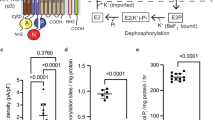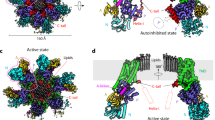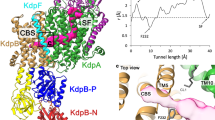Abstract
A prerequisite for life is the ability to maintain electrochemical imbalances across biomembranes. In all eukaryotes the plasma membrane potential and secondary transport systems are energized by the activity of P-type ATPase membrane proteins: H+-ATPase (the proton pump) in plants and fungi1,2,3, and Na+,K+-ATPase (the sodium–potassium pump) in animals4. The name P-type derives from the fact that these proteins exploit a phosphorylated reaction cycle intermediate of ATP hydrolysis5. The plasma membrane proton pumps belong to the type III P-type ATPase subfamily, whereas Na+,K+-ATPase and Ca2+-ATPase are type II6. Electron microscopy has revealed the overall shape of proton pumps7, however, an atomic structure has been lacking. Here we present the first structure of a P-type proton pump determined by X-ray crystallography. Ten transmembrane helices and three cytoplasmic domains define the functional unit of ATP-coupled proton transport across the plasma membrane, and the structure is locked in a functional state not previously observed in P-type ATPases. The transmembrane domain reveals a large cavity, which is likely to be filled with water, located near the middle of the membrane plane where it is lined by conserved hydrophilic and charged residues. Proton transport against a high membrane potential is readily explained by this structural arrangement.
This is a preview of subscription content, access via your institution
Access options
Subscribe to this journal
Receive 51 print issues and online access
$199.00 per year
only $3.90 per issue
Buy this article
- Purchase on Springer Link
- Instant access to full article PDF
Prices may be subject to local taxes which are calculated during checkout




Similar content being viewed by others
References
Serrano, R., Kielland-Brandt, M. C. & Fink, G. R. Yeast plasma membrane ATPase is essential for growth and has homology with (Na+ + K+), K+- and Ca2+-ATPases. Nature 319, 689–693 (1986)
Morsomme, P., Slayman, C. W. & Goffeau, A. Mutagenic study of the structure, function and biogenesis of the yeast plasma membrane H+-ATPase. Biochim. Biophys. Acta 1469, 133–157 (2000)
Palmgren, M. G. Plant plasma membrane H+-ATPases: Powerhouses for nutrient uptake. Annu. Rev. Plant Physiol. Plant Mol. Biol. 52, 817–845 (2001)
Skou, J. C. & Esmann, M. The Na,K-ATPase. J. Bioenerg. Biomembr. 24, 249–261 (1992)
Pedersen, P. & Carafoli, E. Ion motive ATPases. 1. Ubiquity, properties, and significance to cell function. Trends Biochem. Sci. 12, 146–150 (1987)
Axelsen, K. B. & Palmgren, M. G. Evolution of substrate specificities in the P-type ATPase superfamily. J. Mol. Evol. 46, 84–101 (1998)
Auer, M., Scarborough, G. A. & Kuhlbrandt, W. Three-dimensional map of the plasma membrane H+-ATPase in the open conformation. Nature 392, 840–843 (1998)
Harper, J. F., Manney, L., DeWitt, N. D., Yoo, M. H. & Sussman, M. R. The Arabidopsis thaliana plasma membrane H+-ATPase multigene family. Genomic sequence and expression of a third isoform. J. Biol. Chem. 265, 13601–13608 (1990)
Buch-Pedersen, M. J., Venema, K., Serrano, R. & Palmgren, M. G. Abolishment of proton pumping and accumulation in the E1P conformational state of a plant plasma membrane H+-ATPase by substitution of a conserved aspartyl residue in transmembrane segment 6. J. Biol. Chem. 275, 39167–39173 (2000)
Toyoshima, C., Nakasako, M., Nomura, H. & Ogawa, H. Crystal structure of the calcium pump of sarcoplasmic reticulum at 2.6 Å resolution. Nature 405, 647–655 (2000)
Sazinsky, M. H., Mandal, A. K., Arguello, J. M. & Rosenzweig, A. C. Structure of the ATP binding domain from the Archaeoglobus fulgidus Cu+-ATPase. J. Biol. Chem. 281, 11161–11166 (2006)
Morth, J. P. et al. Crystal structure of the sodium–potassium pump. Nature doi: 10.1038/nature06419 (this issue)
Toyoshima, C. & Nomura, H. Structural changes in the calcium pump accompanying the dissociation of calcium. Nature 418, 605–611 (2002)
Sorensen, T. L., Moller, J. V. & Nissen, P. Phosphoryl transfer and calcium ion occlusion in the calcium pump. Science 304, 1672–1675 (2004)
Toyoshima, C. & Mizutani, T. Crystal structure of the calcium pump with a bound ATP analogue. Nature 430, 529–535 (2004)
Jensen, A. M., Sørensen, T. L., Olesen, C., Møller, J. V. & Nissen, P. Modulatory and catalytic modes of ATP binding by the calcium pump. EMBO J. 25, 2305–2314 (2006)
Eraso, P. & Portillo, F. Molecular mechanism of regulation of yeast plasma membrane H+-ATPase by glucose. Interaction between domains and identification of new regulatory sites. J. Biol. Chem. 269, 10393–10399 (1994)
Morsomme, P., Dambly, S., Maudoux, O. & Boutry, M. Single point mutations distributed in 10 soluble and membrane regions of the Nicotiana plumbaginifolia plasma membrane PMA2 H+-ATPase activate the enzyme and modify the structure of the C-terminal region. J. Biol. Chem. 273, 34837–34842 (1998)
MacLennan, D. H., Abu-Abed, M. & Kang, C. Structure–function relationships in Ca2+ cycling proteins. J. Mol. Cell. Cardiol. 34, 897–918 (2002)
Buch-Pedersen, M. J. & Palmgren, M. G. Conserved Asp684 in transmembrane segment M6 of the plant plasma membrane P-type proton pump AHA2 is a molecular determinant of proton translocation. J. Biol. Chem. 278, 17845–17851 (2003)
Dutra, M. B., Ambesi, A. & Slayman, C. W. Structure–function relationships in membrane segment 5 of the yeast Pma1 H+-ATPase. J. Biol. Chem. 273, 17411–17417 (1998)
Pebay-Peyroula, E., Rummel, G., Rosenbusch, J. P. & Landau, E. M. X-ray structure of bacteriorhodopsin at 2.5 angstroms from microcrystals grown in lipidic cubic phases. Science 277, 1676–1681 (1997)
Luecke, H., Richter, H. T. & Lanyi, J. K. Proton transfer pathways in bacteriorhodopsin at 2.3 angstrom resolution. Science 280, 1934–1937 (1998)
Hutcheon, M. L., Duncan, T. M., Ngai, H. & Cross, R. L. Energy-driven subunit rotation at the interface between subunit a and the c oligomer in the F O sector of Escherichia coli ATP synthase. Proc. Natl Acad. Sci. USA 98, 8519–8524 (2001)
Fillingame, R. H. & Dmitriev, O. Y. Structural model of the transmembrane F O rotary sector of H+-transporting ATP synthase derived by solution NMR and intersubunit cross-linking in situ . Biochim. Biophys. Acta 1565, 232–245 (2002)
Olesen, C. et al. The structural basis of calcium transport by the calcium pump. Nature doi: 10.1038/nature06418 (this issue)
Hirsch, R. E., Lewis, B. D., Spalding, E. P. & Sussman, M. R. A role for the AKT1 potassium channel in plant nutrition. Science 280, 918–921 (1998)
Blatt, M. R., Rodriguez-Navarro, A. & Slayman, C. L. Potassium–proton symport in Neurospora: Kinetic control by pH and membrane potential. J. Membr. Biol. 98, 169–189 (1987)
Amory, A., Goffeau, A., McIntosh, D. B. & Boyer, P. D. Exchange of oxygen between phosphate and water catalyzed by the plasma membrane ATPase from the yeast Schizosaccharomyces pombe . J. Biol. Chem. 257, 12509–12516 (1982)
Briskin, D. P. & Reynolds-Niesman, I. Determination of H+/ATP stoichiometry for the plasma membrane H+-ATPase from red beet (Beta vulgaris L.) storage tissue. Plant Physiol. 95, 242–250 (1991)
Kabsch, W. Automatic processing of rotation diffraction data from crystals of initially unknown symmetry and cell constants. J. Appl. Cryst. 26, 795–800 (1993)
Storoni, L. C., McCoy, A. J. & Read, R. J. Likelihood-enhanced fast rotation functions. Acta Crystallogr. D 60, 432–438 (2004)
de La Fortelle, E. & Bricogne, G. Maximum-likelihood heavy-atom parameter refinement for multiple isomorphous replacement and multiwavelength anomalous diffraction methods. Macromol. Crystallogr. A 276, 472–494 (1997)
Cowtan, K. 'dm': An automated procedure for phase improvement by density modification. CCP4 ESF-EACBM Newsletter Prot. Crystallogr. 31, 34–38 (1994)
Strong, M. et al. Toward the structural genomics of complexes: Crystal structure of a PE/PPE protein complex from Mycobacterium tuberculosis . Proc. Natl Acad. Sci. USA 103, 8060–8065 (2006)
Jones, T. A., Zou, J. Y., Cowan, S. W. & Kjeldgaard, M. Improved methods for building protein models in electron-density maps and the location of errors in these models. Acta Crystallogr. A 47, 110–119 (1991)
Brunger, A. T. et al. Crystallography & NMR system: A new software suite for macromolecular structure determination. Acta Crystallogr. D Biol. Crystallogr. 54, 905–921 (1998)
Afonine, P. V., Grosse-Kunstleve, R. W. & Adams, P. D. A robust bulk-solvent correction and anisotropic scaling procedure. Acta Crystallogr. D 61, 850–855 (2005)
Laskowski, R. A., Macarthur, M. W., Moss, D. S. & Thornton, J. M. Procheck—a program to check the stereochemical quality of protein structures. J. Appl. Cryst. 26, 283–291 (1993)
Kleywegt, G. J. & Jones, T. A. Detection, delineation, measurement and display of cavities in macromolecular structures. Acta Crystallogr. D 50, 178–185 (1994)
DeLano, W. L. The PyMOL molecular graphics system on the world wide web. 〈http://www.pymol.org〉 (2002)
Acknowledgements
We thank T. L.-M. Sørensen for contributions to initial project design and E. Pohl, C. Schulze-Briese and T. Tomizaki for assistance with synchrotron data collection. We are grateful to A. M. Nielsen for technical assistance and L. Yatime for help with data collection. B.P.P. is supported by a PhD fellowship from the Graduate School of Science at the University of Aarhus, M.J.B-P. by a post-doctoral fellowship from the Carlsberg Foundation, J.P.M. by a post-doctoral fellowship from the DANSYNC programme of the Danish Research Council, and P.N. by a Hallas-Møller stipend from the Novo Nordisk Foundation.
Author Contributions B.P.P. performed crystallization experiments, collected and processed the data, and determined, refined and analysed the structure. M.J.B.-P. performed expression and protein purification, and later performed crystallization experiments and analysed the structure. J.P.M. assisted in data collection and processing. M.G.P. and P.N. contributed with equal resources, supervised the project and analysed the structure.
Author information
Authors and Affiliations
Corresponding authors
Supplementary information
Supplementary Information
The file contains Supplementary Figures 1-4 with Legends and Supplementary Table 1. (PDF 14383 kb)
Rights and permissions
About this article
Cite this article
Pedersen, B., Buch-Pedersen, M., Preben Morth, J. et al. Crystal structure of the plasma membrane proton pump. Nature 450, 1111–1114 (2007). https://doi.org/10.1038/nature06417
Received:
Accepted:
Issue Date:
DOI: https://doi.org/10.1038/nature06417
This article is cited by
-
Light-induced stomatal opening requires phosphorylation of the C-terminal autoinhibitory domain of plasma membrane H+-ATPase
Nature Communications (2024)
-
The evolution of plant proton pump regulation via the R domain may have facilitated plant terrestrialization
Communications Biology (2022)
-
Augmented CO2 tolerance by expressing a single H+-pump enables microalgal valorization of industrial flue gas
Nature Communications (2021)
-
Structure and activation mechanism of the hexameric plasma membrane H+-ATPase
Nature Communications (2021)
-
Deciphering ion transport and ATPase coupling in the intersubunit tunnel of KdpFABC
Nature Communications (2021)
Comments
By submitting a comment you agree to abide by our Terms and Community Guidelines. If you find something abusive or that does not comply with our terms or guidelines please flag it as inappropriate.



